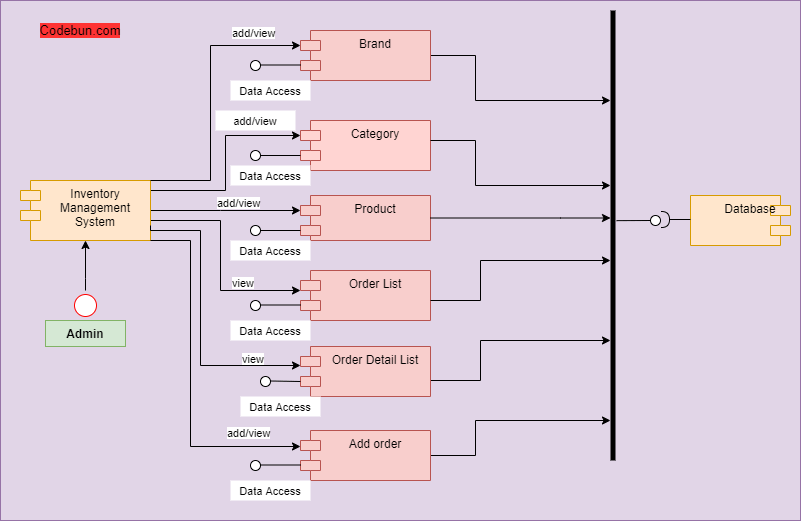UML diagrams for the Inventory Management project. Following are the different UML diagrams like Components, Activity, Use Case, and Sequence diagrams of the Online Fashion Store.
The Inventory Management application will help to manage the shop. It allows the business owner to manage the day-to-day process of managing and maintaining inventories conveniently.
UML Diagram for Inventory Management System
We’ve compiled structural UML diagrams i.e. component diagrams, and three types of behavioural UML diagrams i.e. Activity, Sequence, and Use Case diagrams for the Inventory Management Project. We have also explained the data flow diagram (DFD) for this project.
An inventory management system allows a business owner to track, manage, and generate sales reports, assisting in managing the operations related to the inventories with more accuracy.
Component diagram for Inventory Management Project
The component diagram below shows the structural relations between components in an Inventory Management system. The connected components by lines represent relationships within the systems. In the diagram, it can be seen that there are components namely product, order, customer, and account.
It shows how the customer component connects to the other components while using the system. Everything from the account details to clothes booking to payment flow can be seen in the component diagram.
Admin will be responsible for maintaining the system and also, keeping a check on the products and management of the system, can add/remove/update products from lists, categorize products, check availability of products, etc. Admin can add orders. Admin can view order lists. Admin can add/delete different brands, categories, and different products under these categories and brands.

Activity diagram for Inventory Management Project
Activity diagrams in UML display the functionalities of various activities and flow in management processes and software systems. The flow in the activity diagram can be sequential, branched, or concurrent.
Admin can Add/Remove/Update any details related to the products like brands, products, categories, and types of products, update prices of the products and can categorize, and maintain product databases.
Admin can Add/Remove/Update products, View/Confirm/Cancel orders, manage products/product categories, details, and availability, can manage users, payments, etc. Admin can View/Generate/Track sales reports with the help of this module.
Admin can add orders, view order list, and order detail list.

Sequence diagram for Inventory Management Project
Sequence diagrams in UML are used to illustrate the sequence of messages between objects in an interaction. A sequence diagram consists of a group of objects that are represented by lifelines and the messages that they exchange overtime during the interaction.
From the below sequence diagram of the Inventory Management System, we can see that only Admin have the responsibility of performing every action in the system. Everything from adding brands to adding orders can be done by the admin.

Use Case Diagram for Inventory Management Project
A UML use case diagram can create a broad, high-level view of the relationship between use cases, actors involved, and systems being performed.
As you can see from the examples below, use cases are represented by oval shapes, and the lines then show at which point an actor/user participates and interacts with their corresponding use case. You can see where each actor is involved within the entire process (and where they’re excluded).
Since this is a single-user system, Admin is the only user that has access to each and every use case of the Inventory Management System.

DFD for Inventory Management Project
A data flow diagram represents the flow of information for any process or system. It shows the system with its relationship to external entities. Here, we can see how the users and the process flow work in a system.
After logging in, Admin will land on the home page where they can manage their profiles. Admin can add, view products, manage prices of products, view bookings, check the availability of the products, etc. Admin can Add/Remove/Update products, View/Confirm/Cancel orders, manage products/product categories, details, and availability, can manage users, payments, etc.

